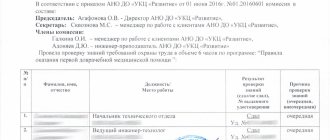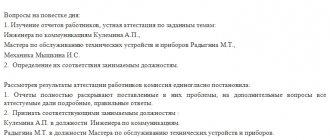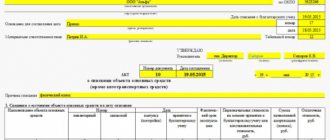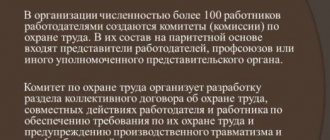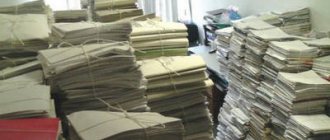The procedure for writing off inventory items
Writing off inventory items requires compliance with a certain procedure:
| Write-off stages | What does the stage include? |
| Stage 1: Conduct an inspection | At this stage, a thorough inspection of material assets subject to write-off takes place. |
| Stage 2: Conducting technical expertise | If this is required, a technical examination is carried out. |
| Stage 3: Drawing up a conclusion | When compiling the examination, the commission must take into account the technical indicators, the malfunction of which was the reason for the liquidation. The conclusion is regarding repair, modernization, as well as liquidation of inventory items. The conclusion is signed by all members of the commission and the head of the organization. Based on this conclusion, an act of write-off of valuables with removal of equipment is drawn up. |
Depending on what exactly caused the write-off of inventory items, various write-off schemes are used. When completely worn out, the following is written off:
- initial cost;
- depreciation;
- depreciated fixed assets.
Important! Upon completion of the commission’s work, the accountant writes off the equipment so that there are no problems with taxation. For this purpose, an act drawn up by the commission is used.
https://youtu.be/nA7CdQbg1HA
Stages of implementation
All work on checking cash and non-cash positions on the estate of a government agency is divided into several stages.
The first stage is preparation. By the beginning of the audit, the accounting department must complete work with all documents on receipts and issues of material assets, as well as make the necessary entries in the list of analytical accounting registers, having determined in advance the balances on the day of the audit.
You may be interested in: Colombian peso: photo and description, history, course
The second stage is the direct conduct of an inventory in a budgetary institution. Appropriate forms are prepared for entering data based on the results of the inspection, the names of the commission members are entered, specific items subject to inventory are counted, weighed, and measured, after which the premises subject to inspection are sealed to prevent forgery or subsequent theft of the inventoried property.
The third stage is the preparation of inventory records. The forms specifically established by current legislation regulate the completion of inspection results for fixed assets, intangible assets, other intangible assets and inventories, the presence of cash and valuables, as well as strict reporting forms, settlements with debtors and creditors and material assets in storage.
The fourth stage is checking the completed inventories. Here the results of the inventory of fixed assets in a budgetary institution, liabilities, assets and cash are summed up. At this stage, surpluses and shortages of the enterprise's property are identified.
Who can be included
The commission may include any employees of the enterprise who have the necessary education, qualifications, knowledge and skills to resolve certain issues. As a rule, these are specialists of a sufficiently high level, allowing them to solve the tasks assigned to them.
In some cases, third-party experts may also be involved in the commission, for example, if the matter concerns some high-tech equipment, machinery, specific objects, etc.
In order for the commission to work “without a hitch,” a chairman is selected from among its members, who is responsible for carrying out all necessary activities, as well as drawing up accompanying documentation. Sometimes, if there is a special need, a secretary of the commission is also appointed.
In any case, each specialist included in the commission must be mentioned in the relevant order of the head.
Rules
The rules for conducting an inventory in a budgetary institution are regulated by current legislation. One of the main requirements for the correct inspection of government property is the mandatory formation of the composition of the commission. An order for inventory in a budgetary institution establishes specific persons who will be members of this commission. The circle of persons submitted to the inspection includes exclusively employees of the staff of this enterprise, but not third parties in the form of expert appraisers, employees of state inspections, and so on. Mandatory representatives of the commission are the chief and ordinary accountant, and it is headed by the head and his deputy. It is important to note that financially responsible persons cannot be part of the inspectors. In addition to the members of the inspection team, the director of the institution approves in the order the specific timing of the inspection. Upon completion of the inventory of property in a budgetary institution, shortages and surpluses are analyzed, the culprits are identified, and administrative penalties are imposed on the guilty persons, if any.
On the composition of the commission for writing off fixed assets and inventory items
Based on the results of the work of the CSC for the specified period, management assesses its effectiveness and formulates certain organizational conclusions (on the need to reduce or expand the number of CSC, change the structure, adjust the work regulations, etc.).
Any enterprise, regardless of its form of ownership, must have such a commission. If it is necessary to write off the fixed assets of an enterprise, then the order is drawn up after an inventory has been taken, based on the results of which a list of inventory items unsuitable for further use is specified. Most often these are spoiled, broken, morally outdated values.
The write-off procedure is carried out both according to the schedule approved by the manager, and unscheduled, when the basis for it was the loss of valuables (or working properties) after exposure to third-party factors.
If the act is issued after an inventory has been carried out, then the basis for the paper should be its results, or rather, the documents that were obtained as a result of the inventory.
Inventory concept
You may be interested in: Assistant Chief Accountant: appointment, conditions of employment, job descriptions and scope of work performed
Inventory, by its primary definition, means a recalculation of cash positions listed on the property records of an enterprise, with a specific comparison of the results obtained with the previous check. This word initially brings to mind the familiar term called “inventory”. But it is worth noting that the process of conducting an inventory in a budgetary institution involves a quantitative measurement of not only economic assets or inventory items that are assigned to financially responsible persons, but also a list of funds stored in bank accounts and in cash (at the cash desk), settlements with debtors and creditors, as well as financial obligations. The main goal of this event is to identify surpluses or shortages that may arise in the course of business activities, as well as to search for possible errors that were made by employees of various areas of the economic functioning of the enterprise as a whole. Based on the results of the inventory in a budgetary institution, those responsible for shortages are subject to disciplinary punishment in the form of a reprimand or deprivation of bonuses, as well as compensation for damages incurred.
You may be interested in: Bank loans from 21 years of age: age standards, application procedure
Channel PROGRAMMER'S DIARY
The life of a programmer and interesting reviews of everything.
Subscribe so you don't miss new videos. https://youtu.be/fQO8S63TtQc
***
The Regulations on the Commission for the Write-off of Material Assets describes the procedure for the work of specially appointed company employees (commission members) to inspect the assets, identify the causes of malfunctions in them, identify the perpetrators, draw up acts for write-off, and formulate economically justified conclusions about the inappropriateness of repairing an object that has become unusable.
This document can include an algorithm for calculating the composition and number of commission members, as well as other organizational issues (how often commission meetings are held, how long it takes for write-off acts to be submitted to management for approval, etc.).
Sample form for write-off of inventory items
Due to improper storage or deterioration of a particular product, it may become unusable and therefore must be written off.
Such an operation is accompanied by a written document, namely an act of writing off inventory items.
In order to write off a particular product, a commission is selected that evaluates the condition of the product and decides whether it needs to be written off.
The corresponding document has a standard written form and is drawn up in triplicate.
The first type of document is drawn up directly to the accounting department itself, the second copy is transferred to where the products are stored, and the third type remains with the person who is responsible for the relevant values, but for convenience, the accountant himself is appointed as the financially responsible person.
Certificate of write-off of inventory items
The law does not stipulate the form for filling out the corresponding certificate, but this document must be equipped with basic information.
How to apply?
Material assets become unusable if they lose their properties and characteristics due to breakage, deterioration, or expiration of their useful life.
Such materials must be removed from account 10, written off by completing the necessary documentation. In particular, an act for writing off the MC is drawn up, which is formed by the established commission.
The act serves as the primary document for the accountant to make entries for deregistration of valuables.
In what cases is a cash register inventory carried out?
There are two types of cash register inventories - planned inventory and unscheduled (sudden) audit of the cash register.
A planned inventory of the cash register is carried out in cases established by regulations; its timing and regulations are approved in advance in the accounting policies and other additional administrative documents of the organization.
https://www.youtube.com/watch?v=ytadvertise
So, it is necessary to carry out an inventory of the cash register:
- when transferring the organization’s property for rent, redemption, sale, as well as in cases provided for by law during the transformation of a state or municipal unitary enterprise;
- before preparing annual financial statements;
- when changing financially responsible persons (on the day of acceptance and transfer of cases);
- when establishing facts of theft, abuse, damage to valuables;
- in case of force majeure, in case of natural disasters, fire, accidents or other emergencies;
- during the liquidation (reorganization) of an organization before drawing up a liquidation (separation) balance sheet and in other cases provided for by the legislation of the Russian Federation or regulations of the Ministry of Finance (based on clause 1.5 of Methodological Instructions No. 49).
An unscheduled inventory of the cash register (audit), on the contrary, is carried out suddenly, unexpectedly for the financially responsible person in order to check his integrity and competence. For example, a cash register audit is carried out:
- to strengthen the internal control system at the enterprise;
- identifying the cause of an accounting error;
- at the request of auditors, investigative and control authorities.
The current legislation does not define the timing of a sudden (unscheduled) inventory of the cash register, so organizations and entrepreneurs determine them independently. The order for an unscheduled inventory should indicate the reason for such an inventory of the cash register.
Who can be included
The commission may include any employees of the enterprise who have the necessary education, qualifications, knowledge and skills to resolve certain issues. As a rule, these are specialists of a sufficiently high level, allowing them to solve the tasks assigned to them.
In some cases, third-party experts may also be involved in the commission, for example, if the matter concerns some high-tech equipment, machinery, specific objects, etc.
In order for the commission to work “without a hitch,” a chairman is selected from among its members, who is responsible for carrying out all necessary activities, as well as drawing up accompanying documentation. Sometimes, if there is a special need, a secretary of the commission is also appointed.
In any case, each specialist included in the commission must be mentioned in the relevant order of the head.


